Text
Brilliant Ways to Use Apple Cider Vinegar in Your Hair and Skin Routine
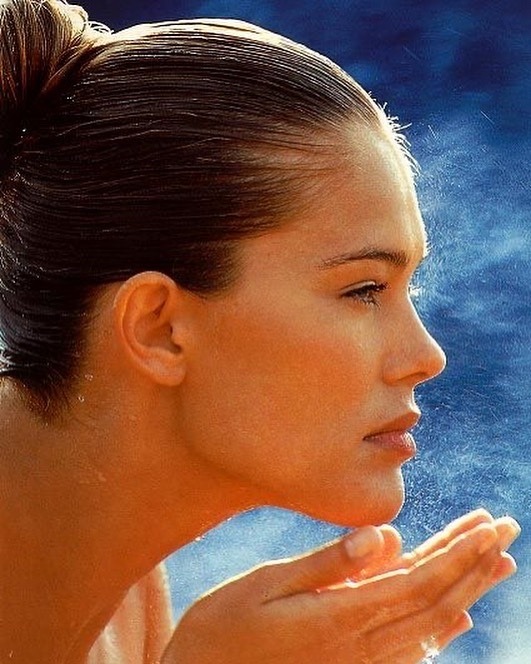
Source: Jessica Cruel via POPSUGAR
Photo: Nineteenikey on Instagram
Our vanity is lined with bottles of olive oil and coconut oil for easy access when we get an urge to DIY. Vinegar is the latest kitchen staple we've added to our bathroom beauty stock. Vinegar has a slew of benefits when added to your regular hair and skin care routine. You can use it to clear up dandruff, soothe dry skin, and disinfect your makeup brushes.
Naturally, apple cider vinegar (which is the best choice for topical applications) is an antifungal, antibacterial, and anti-inflammatory. ACV also has alpha-hydroxy acids and acetic acid built in, so it can give your skin a much-need exfoliating treatment while balancing pH. Keep reading to discover 10 uses for vinegar outside of the normal egg-dying, salad-garnishing realm.
1. Soothe itchy skin
Pour one cup of apple cider vinegar in your bath water to let the anti-inflammatory properties soothe itchy skin caused by eczema or psoriasis.
2. Reveal Shiny, Brass-Free Hair
Apple cider vinegar can act as a clarifying step to remove any product buildup. Apply five drops of vinegar (mixed with cold water in a bowl) on hair and scalp after you've thoroughly rinsed out your conditioner. You can even leave the ACV rinse in to help give strands extra shine.
3. Smoothe Skin From Head to Toe
The acidity of vinegar helps to tighten pores and dissolve dry skin. So, it's not just good for your face. Add a few drops in your body or hand cream to get the brightening effects over every inch of your skin.
4. Tone and Tighten Pores
Vinegar balances the pH of the skin and acts as an astringent on oily complexions. Stir up a half-and-half mixture of apple cider vinegar and water to use as a toner before your daily moisturizing routine. ACV also has natural alpha-hydroxy acids that gently exfoliate dead skin.
5. Blast Away Dandruff
Apple cider vinegar has natural antifungal properties and therefore can help eliminate a flaky scalp caused by dandruff. Create your own cleansing shampoo by mixing a solution that's half water and half apple cider vinegar into a spray bottle and apply.
6. Remedy Razor Bumps
Dip your cotton ball in undiluted apple cider vinegar and wipe over razor bumps to soothe the ache and disinfect the area. The anti-inflammatory properties of vinegar will help take down any redness, and the acidic pH helps eliminate ingrown hairs.
7. Detox Mask
For a serious detox mask, mix one teaspoon of apple cider vinegar with a teaspoon of bentonite clay (or any other clay of your choosing). The ACV works to exfoliate and balance pH, while the clay extracts impurities from the pores.
8. Cleanse Your Makeup Tools
Yes, you can revive your dirty makeup brushes with a simple mix of soap and water. But as an extra disinfecting step, you can dip your tools in a solution of water and vinegar.
9. Ease Sunburn
Prevent blisters and peeling by applying a washcloth soaked in a vinegar solution (one part ACV, four parts water). The balm will help reduce swelling, redness, and burning because vinegar has anti-inflammatory properties.
0 notes
Text
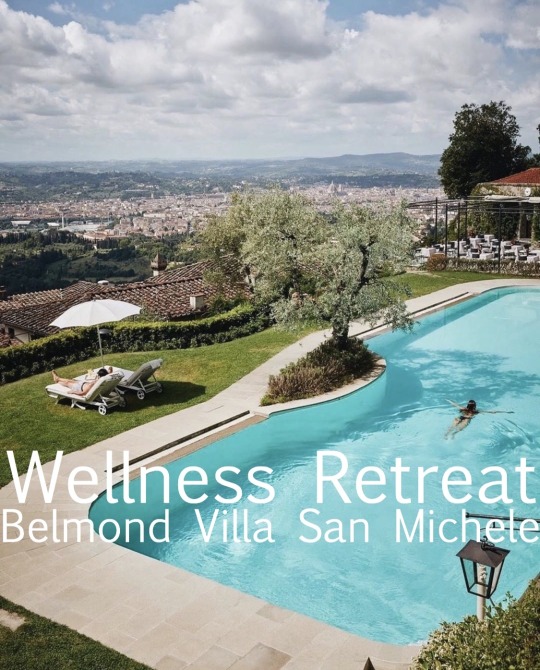
Wellness Retreat Series: Belmond Villa San Michele, Florence, Italy
Source: @belmondvillasanmichele instagram and official website
Images: @belmondvillasanmichele
A place where Renaissance spirit meets modern indulgence.
Surrounded by lush trees and terraced gardens with views down to Florence, our location is hard to beat. Step inside and experience the beauty of a Renaissance monastery that is as much a part of Italy's culture as the country’s greatest cathedrals and galleries.
Today, Belmond Villa San Michele is recognised as one of the country’s finest small boutique hotels. Stroll in the Italian gardens, bursting with lemon trees and fragrant roses, and savour superb Tuscan cuisine on the alfresco loggia as if in a private home.






1 note
·
View note
Text
Why Tiger Grass, or Centella Asiatica, Is a Skin-Care Ingredient to Keep on Your Radar
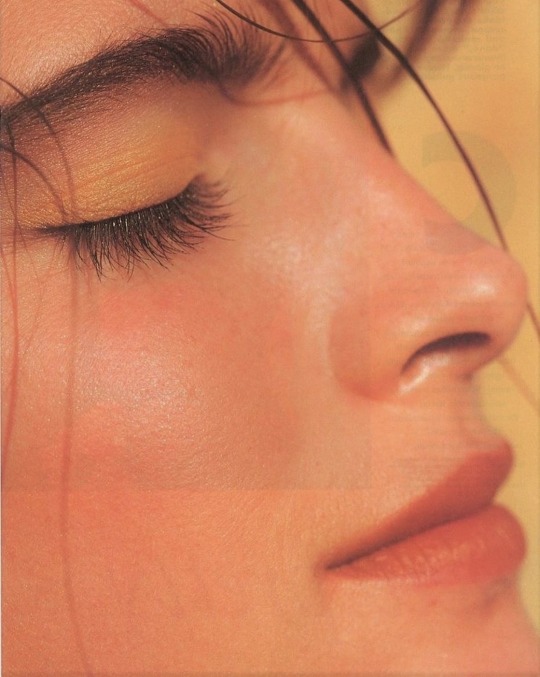
Source: Margaret Fisher via skincare.com
“Tiger grass” may sound like something straight out of the jungle, but it’s actually an ingredient that’s making its way into all sorts of skin-care products. If you haven’t heard of it, chances are you will soon. The ingredient, also known as centella asiatica, is rising in popularity and we’re fully on board. Ahead, find out what tiger grass is and why you’ll want to give it a spot in your skin-care routine.
What Is “Tiger Grass”?
According to the National Center for Biotechnology Information (NCBI), tiger grass or centella asiatica is a medicinal plant that has long been widely used in the East and has recently started to gain traction in the West. The NCBI also reports that centella asiatica has been referred to as a “panacea,” as well as a “miracle elixir of life,” for thousands of years.
The Benefits of Tiger Grass and Centella Asiatica
Centella asiatica is most well-known for its wound-healing abilities. In fact, legend has it that centella asiatica got its nickname of “tiger grass” from tigers that would roll around in the plant after battle in an effort to soothe their wounds. While we can’t confirm the legitimacy of that tale, the NCBI does state that centella asiatica has traditionally been recommended for wounds. Additionally, the NCBI also states that centella asiatica has been used to address a wide-range of dry skin-related conditions thanks to its ability to improve skin hydration and that it’s a suitable ingredient for anti-aging formulations.
To learn more about centella asiatica, we reached out to board-certified dermatologist and Skincare.com expert, Dendy Engelman, M.D., who is a big fan of the ingredient in skin care.
“It contains saponins, which serve to be anti-inflammatory,” says Dr. Engelman. The NCBI confirms that in addition to all its other uses, most formulations with centella asiatica can complement dry and sensitive skin.
0 notes
Text
Wellness Retreat Series: Anantara Al Jabal Al Akhdar Resort in Oman

Source: Conde Nast Traveler
Set in the sunburnt Al-Hajar mountains, on the rim of the Arabian Peninsula’s most outrageously beautiful canyon, is the region’s most ambitious wilderness hotel. This is Oman’s wild frontier, but this space has souped it up to the max, with chasm-facing pool villas, majlis-style courtyards, a lantern-lit outdoor hookah space, and superslick service fit for a sultan (a little jealous, perhaps, Omani premier Qaboos bin Said is building a palace on the canyon lip opposite). This being the splashy Gulf of Oman, there has to be a superlative or two: The hotel has the highest swimming pools, tennis court, and stargazing platform in the Middle East. But its real essence is pure escapism, whether dangling from a mountain while rappelling or relaxing in the impeccable spa with its energizing hammam rituals and fragrant frankincense oils. It’s a bold, almost transcendental experiment in off-the-map tourism, and at the vanguard of a growing number of Middle Eastern hotels opening in unexpected and wonderfully extreme locations.







0 notes
Text

Christophe Robin Purifying Scalp Scrub with Sea Salt
#Genius Products
A scalp exfoliator and shampoo all in one that cleanses, removes buildup, and soothes sensitive, flaky, and oily scalps by Christophe Robin.
Highlighted Ingredients:
- Sea Salt: Helps purify by removing residue.
- Sweet Almond Oil: Provides long-lasting hydration and soothing benefits for the scalp.
Free of parabens, formaldehydes, formaldehyde-releasing agents, phthalates, mineral oil, retinyl palmitate, oxybenzone, coal tar, hydroquinone, triclosan, and triclocarban, and contains less than one percent of synthetic fragrances. This product is also vegan, cruelty-free, and comes in recyclable packaging.
This scalp exfoliator and shampoo removes styling product and dry shampoo buildup and chemical residues from color treatments, while working to rebalance itchy and/or oily scalps. Formulated with sea salt, a natural exfoliant, this shampoo also eliminates impurities and supports natural, healthy blood circulation.
Hair Type: Straight, Wavy, and Curly
Hair Texture: Fine, Medium, and Thick
Hair Concerns: Oiliness, Flaky and Dry Scalp, and Color Safe
Suggested Usage:
-Use as a shampoo and apply a small amount onto wet hair.
-Delicately massage into the scalp, add some water, lather, and rinse thoroughly.
-Always follow with a nourishing treatment on lengths and ends.
This product is an Allure Best of Beauty award winner.
0 notes
Text
Why Reading Can Be Good for Your Mental Health

There is no doubt that reading is an intellectually stimulating experience. Reading not only improves your brain's connectivity, it also increases attention spans, focus and concentration. If you struggle to focus, reading can improve your attention span. Research shows that reading helps with fluid intelligence, reading comprehension and emotional intelligence as well.
“Fluid intelligence” is that ability to solve problems, understand things and detect meaningful patterns. Reading can increase fluid intelligence, and increased fluid intelligence also improves reading comprehension. However, there is more to it; Reading is known to improve mental health. First and foremost, it reduces stress. Research shows that reading as little as six minutes a day can reduce stress levels by 60% by reducing your heart rate, easing muscle tension and altering your state of mind. That same study showed that reading was better at reducing stress than music, drinking a cup of tea, going for a walk and playing video games. Closely linked to reducing stress levels when you read is the ability to escape from the real world. Escapism is complex but reading certainly supports it.
People who read fiction have been shown to improve level of empathy, the ability for you to understand someone else’s belief’s, feelings and thoughts. Research has shown that people exposed to fiction predicted the results of an empathy task and even positively correlated with social support (but remember correlation does not mean causation!). Further research into the impact of fiction on empathy showed that it was temporarily enhanced after reading fiction.
Participating in cognitive activities, such as reading over your life time (both early and later in life) was shown to slow down memory loss when compared to those who didn’t participate in mentally stimulating activities. The same study also found that the rate of mental decline was reduced by 32% when people participated in reading, writing and other activities later on in life.
Furthermore, there is scientific research that shows that reading and then talking about what you have read could be beneficial to mental health and well-being. There is something called bibliotherapy and it has a profound effect on people suffering with depression. Liverpool Health Inequalities Research Institute examined a two weekly reading group program for people diagnosed with depression over a 12-month period and reported a significant improvement to mental health. Participants reported improved concentration, better emotional understanding, increased self-awareness, and the ability to discuss meaningful issues related to self and being.
Research has shown that reading in fact make us smarter. I often feel smarter after reading books, I learn new things, experience different cultures, understand myself better. Cognitive differences have been seen between those who read a lot and those who read a little. People who are exposed to more written information are associated with higher vocabulary, general knowledge, and verbal skills.
0 notes
Text
Nail Care Tips: How to Keep Healthy Nails at Home

Source: Asia Milia Ware via teenVOGUE
How To Strengthen and Grow Your Nails
“For starters, what you put into your body has a lot to do with the health of your nails. Your water intake and diet has a lot to do with the strength of your nails. What you take in internally, will always surface externally.” Then, choose “restorative treatments for natural nails that stimulate growth and anti-breakage. Calcium and protein-infused products aid in strengthening nails in addition to diet and water intake. The best way to kick off taking proper care of your nails is to focus on strength and growth because oftentimes weak nails result in breakage and splitting.”
Take Care Of Your Cuticles
Following proper care for the strength and growth of your nails is just the first step, caring for your cuticles is just as important, if not more. If you don’t have cuticle oil in your home use this old trick: take olive oil and put it around your cuticles. It’ll keep them moisturized. Apply at night before bed so they can sit overnight while you’re sleeping. Cuticles can be super delicate, but because they protect our nail growth from bacteria, they are essential part of caring for your natural nails.
Moisturize Your Hands
Not only do you have to worry about your nails, but your hands are also an essential part of nail care. Now more than ever, washing your hands is being more enforced, which can result in drying out your skin. The best way to tackle dry hands is to keep them moisturized. You can even get creative! Play with lotions you like, create mixtures of oils your skin responds best to. Track your progress with your custom mixes and see what changes your nails and hands are making.
0 notes
Text
Ways To Avoid Bloating After Eating Fruit
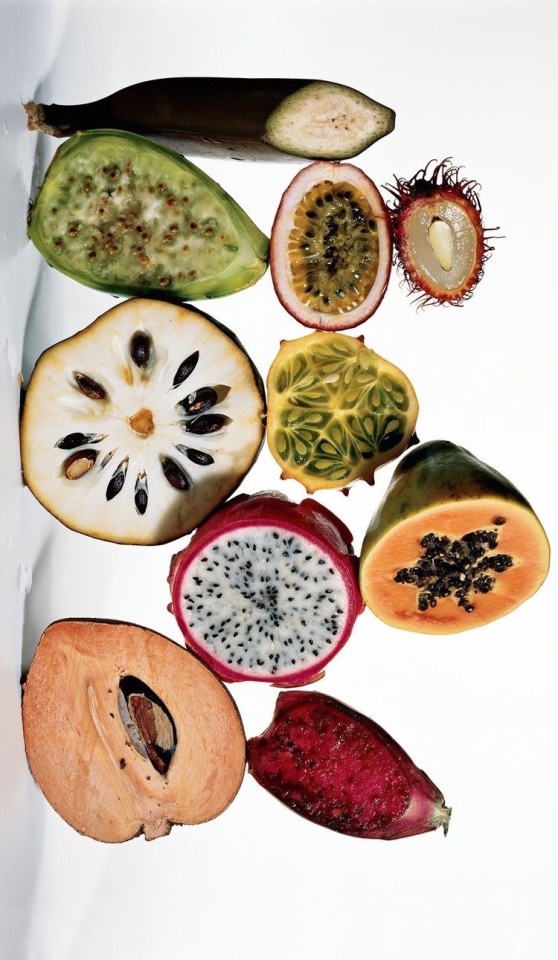
By Ana Morales via Vogue Australia
Photo: Irving Penn
There are no fruits that should be avoided. None can be labelled as ‘not recommended’ because they all have great benefits due to their high vitamins, minerals and antioxidant content, says Nela Berlanga, pharmacist and nutritionist at KilosOut. It’s vital to eat three to five pieces of fruit a day—whatever the fruit is. While Berlanga says that there are no universal rules on nutritional issues—“something good for one person can be upsetting for another”—she does note that there are certain fruits that can make you feel bloated and gassy. “Fruits have sugars such as fructose and sorbitol, and these two nutrients can cause inflammation and gases,” she says. “They also contain fibre, which we all need for healthy gut function, but when consumed in excess it can result in lower digestibility, causing greater abdominal swelling and gases.” Even though this article contains a list of fruits that can actually cause the dreaded stomach bloating—and if you’re reading this, it’s probably why you’re here—it’ll also provide ways of still eating those fruits and avoiding those unwanted symptoms. The key is reducing the effects of bloating, rather than blacklisting the fruits themselves and therefore missing out on their positive properties.
Learn which fruits cause bloating.
As Berlanga says, we shouldn't think that all fruits have the same effect on everyone, hence the importance of observing what we eat, how we eat it and how we feel afterwards. The truth is that there are certain fruits that can generally produce more inflammation. Apples, bananas, grapes and figs have higher sugar (fructose) levels and not all of that sugar may be fully absorbed, causing inflammation. Berlanga recommends eating seasonal fruits at their ripest.
The importance of slow eating.
Although this golden rule should always be followed, in the case of bloat-producing fruits, it is mandatory. It’s about chewing these fruits a lot to help digest all their fructose. “It is also very important to eat slowly, drinking enough water and to keep an eye on other foods that might be contributing to bloating,” Berlanga points out.
Mix them with kefir.
If you find these (or other) fruits hard to digest, an option is to combine them with probiotics such as fermented dairy products, since according to Berlanga, “to some extent they help regulate our gut flora.” Think about adding them to kefir or natural yogurts.
Have a warm infusion afterwards.
Berlanga says that certain spices such as oregano, cinnamon, fennel, mint, ginger, bay leaf and sage have an eupeptic effect, meaning they increase our gastric juices and improve digestion as a result. Try infusing them into a warm drinks after you eat fruit; they may reduce bloating.
Learn when you bloat throughout the day—and manage it.
Berlanga reminds us that fruit bloating varies from one person to another. For example, the unwritten rule that advises against eating fruit after lunch or dinner is a more individual question rather than a universal law. “Eating or not eating fruit after a meal is a personal issue,” says Berlanga. “In the case of some people with slower digestion, it stays in their stomach longer and produces more gas or swelling. It depends on how balanced your gut flora is and whether you have any digestive pathology.” Berlanga advocates for having fruit during breakfast to fuel up, but she also recommends it in the afternoon: “Regarding the theory that advises against having fruit after 2pm, there is no solid proof of a greater spike in blood sugar, nor that our body will lack time to stabilise those levels and store it. In fact, if we stop eating fruit in the afternoon, we might be hungry, turn to unhealthy snacks and gain weight. Fruit is the perfect non-fattening healthy snack.”
Eat more bananas.
Given that bananas are on the list of fruits that can cause bloating, and some nutritionists advise against eating them when trying to lose weight. We turned to the expert for her take on the advantages of eating the yellow fruit. “Banana is a superstar fruit,” says Berlanga. “It does have more sugar than other fruits, but it’s intrinsic, healthy sugar. Not only do we not advise against eating bananas, but we recommend having one daily since they are rich in potassium and tryptophan, a precursor of serotonin (the hormone of the 'good vibes'). Furthermore, you can carry one easily inside your bag for a snack, they won’t stain anything and comes with natural packaging… and they’re delicious!”
2 notes
·
View notes
Text
How to Make Your Showers Feel More Soothing in Self-Quarantine

Source: Lauren Valenti via Vogue
In isolation, showers are becoming something different. Amid stress, uncertainty, and, well, excess time, stepping into the shower is no longer just a utilitarian to-do, it’s an act of serene self-care—particularly when you take your time and add those few extra steps that transform it into a fully realized ritual. From creating a warm, grounding environment to therapeutic skin-care treatments, here’s how to make your shower a place of respite and relaxation.
Create Warm, Relaxing Lighting
Warm lighting, particularly in the evening, promotes relaxation and helps to calm the mind. Whether you’re bathing before bed or just in need of a dose of grounding glimmer during the day, flick on a small accent light that emits a soft, mellow glow. Try a stylish midcentury-inspired orb, small paper lantern light, or a compact pinky-peach Himalayan salt wall plug, which will help cleanse the air in your space.
Light a candle
A beautiful candle is a true luxury. In a bathroom setting, it not only offers a scent that makes you feel feel good, but it secures that ever-soothing candler-lit ambiance at night. In these taxing times, consider notes that whittle away at stress such as balancing Breu resin, sweet earthy vetiver, or grounding cedar.
Dry Brush for a Full-Body Massage
Before entering the shower, take a dry brush and gently massage yourself head to toe in long, circular strokes that move up towards your heart. It contributes to lymphatic drainage and increased circulation and, according to Ayurvedic philosophy, is a mediative act of cleansing and detoxifying the body. Plus, it helps buff away dead skin cells as the first step for a full-body glow.
Embrace Aromatherapy
Once you’ve turned the faucet and found that perfectly calibrated warm temperature, consider a little aromatherapy behind the curtains. Hang a bouquet of fresh eucalyptus from your shower head for a refreshing natural scent, or try an in-shower mist like the J.R. Watkins's new Detox formula laced with warming ginger, or a shower melt like Aura Cacia's calming lavender tablets.
Exfoliate All Over
Your body will already be buzzing from the dry brushing session; up the ante on smooth, soft skin and muscle tension relief with a polishing body scrub. Ren’s clean sea salt balm contains a touch of magnesium for its calming and detoxing properties, while Juara’s creamy polish teams candlenut oil with crushed walnut particles for an extra-silky effect all over. And don’t forget your scalp: A purifying scrub, such as French hairstylist Christophe Robin's cult favorite, will help cleanse, remove build-up, and leave the scalp feeling truly revitalized.
Cleanse Luxuriously
Just as important as how you feel in the shower, is how you feel walking out of it—for those who enjoy fragrance, a fresh, long-lasting scent is a key part of the equation. Look to a gentle body cleanser infused with a magic, sweet-smelling ingredient.
For your post-shower ritual, don’t forget to use a nice body ointment, body butter or cream to nourish your skin.
1 note
·
View note
Text
Water Healing

Source: Spiritual teacher & energy healer Deborah King via deborahking.com
#GeniusMeditationClub
The summer season is all about water, an elemental force for good. Whether you’re swimming in a pool or lake, walking along a beach or river, or sitting under misters on a restaurant patio, chances are that many of your summer hours will be spent in or around water. Of course this is fun all on its own, but did you know that water is also an incredible tool for healing your mind, body, and soul? Just like energy healing, water is both preventative and curative, and these upcoming months are the ideal time to take advantage of the many ways you can soak up the therapeutic effects of water for increased health and happiness.
Water for Life
On a most basic level, water is necessary for life. You can’t survive without drinking water, and over my many years as a spiritual teacher and energy healer, I have found that most people also feel comforted by water—both by being immersed in it as well as just being near water. Think about how much better you feel after a dip in the ocean or a walk along a waterfront path, or even after a shower: relaxed, refreshed, calm, clearheaded, and probably happier, right? Well there are good reasons for that. Water cleanses you of negativity, reduces stress, and clears and recharges your chakras.
Eight Glasses Each Day
First and most importantly, water is essential not just to your physical survival, but to the health of your physical body. Obviously, you would die without enough H2O, but studies show that most people don’t get enough and are actually mildly dehydrated without realizing. Dehydration symptoms can include things that you may not associate with a lack of water like headaches, muscle aches, fatigue, dizziness, dry mouth, dry or irritated skin, mental fuzziness or lack of focus, inflammation, digestive issues, toxin buildup, and even depression and anxiety. Severe dehydration can cause increased heartbeat, rapid breathing, fever, and delirium, so be sure you get the recommended eight glasses a day as a minimum, and if it is warm or you are exerting yourself, you need to drink even more.
Water Makes You Happier
Water has healing benefits for the intangible parts of your being, too. At my energy healing courses and workshops, I have heard countless stories from students who say that they can’t be depressed at the ocean, or that they have found solace in simply sitting on a river bank and watching the water flow. I’ve come to internalize this truth, too; it’s why I’ve lived at a series of lakeside houses so I can see the water while I work: it is nearly impossible to feel bad around water. Moving air and water—waterfalls, ocean waves, babbling brooks, even showers—release negative ions which are molecules that have gained or lost an electric charge and are known to improve moods. In other words, being around moving water really does make you happier.
Water also soothes your mind and reduces stress, just like meditation. The sheer number of people who flock to beaches and lakes during the summer to escape the stresses of normal daily life is evidence of water’s power to heal the mind, as is the fact that thousands of people choose to fall asleep to the sounds of water, whether real or electronic, because the rhythmic crashing of waves or the tinkling of river water over smooth stones is comforting. Water inspires peace because it feels safe and nurturing—after all, you were held by water in the womb as you were formed. Listening to the soothing consistency of moving water moves you toward serenity, and healing is easier from a place of peace.
Water: A Conduit of Universal Energy
Water is also spiritually healing since it is a conduit of universal energy. It can literally wash away negative energy that has become lodged in your chakras from past heartbreak or trauma, and clear any negative energy that has rubbed off from someone else and gotten stuck to you. Saltwater is especially healing, as salt has its own healing properties, so the combination of salt and water is particularly potent. Now you have another reason to get in the ocean this summer! Swimming in the ocean for twenty minutes acts as a cleanse and rejuvenator as well as removes any low level negative energy you’ve picked up from others. If you can’t make it to the ocean, a bath filled with a pound each of sea salt and baking soda will do the trick.
Just like journaling, meditation, and other energy medicine techniques, being around water will help to keep your chakras balanced and spinning in the right direction, which will keep your field and body healthy. So go out and get in the water! And this summer, don’t take the restorative properties of water for granted. Get the most out of your water activities by imagining the negativity being washed away, leaving you lighter, healthier, and happier.
0 notes
Text
What Your Fingernails Say About Your Diet
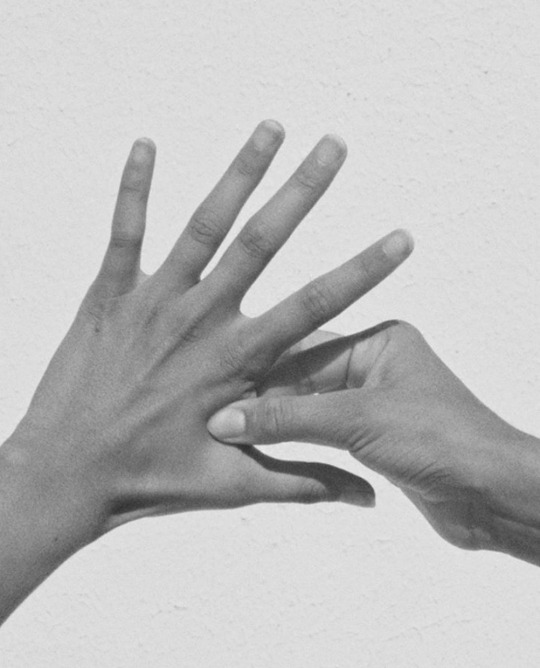
Believe it or not, what we consume on a day to day basis can effect our fingernails making them look sturdy and strong or shabby and worn out. We use our nails for almost everything that we do whether it is peeling an orange, scratching a lotto ticket or drumming our nails on the dash board waiting for the light to go green. Depending on the nutrient deficiency, our nails can show different signs of wear and tear. The following are some of the different concerns that many people may run into, the possible reasons for the problems and some suggestions to reverse it.
1) The Nail bed is spoon-shaped or pale rather than pink
This problem may reflect low iron. To increase your iron intake eat more fish, meat and poultry. Plant sources that are a good source of iron include artichokes, kidney beans, nuts, tomato juice and broccoli. Just remember that plant sources are better absorbed with a source of vitamin C or animal protein. Try a mixed green salad with strawberries, artichokes and nuts for an iron rich meal.
2) Nails that have side to side ridges
This can often occur with high fevers and inflammation in the body for extended periods of time. By boosting your immune system with nutrient dense foods you can help combat illness.
3) Nails that have longitudinal ridges from cuticle to nail tip
May be due to a lack of biotin which weakens the protein layers below the skin line where ridges begin. For biotin eat more egg yolks, dark green vegetables and green beans. For some, ridges are just a fact of life and actually develop with age. However, the good news is it is not a sigh of a health problem and not something to worry about.
4) Brittle nails
Brittle nails can often occur due to lack of protein, iron and/or the amino acid cysteine in the diet. For protein and iron eat more foods from the meats and alternatives group. For cysteine eat chicken whole grains, eggs, nuts and seeds.
5) Nails that are dry, combined with ridges
This may occur due to a lack of B vitamins in the diet. B vitamins are powerful coenzymes that assist particular enzymes in the release of energy from carbohydrate, fat and protein. Deficiencies of these vitamins can directly disturb metabolic pathways. B vitamins, including thiamin, riboflavin, niacin, pantothenic acid and biotin, can be found in a variety of food sources such as whole grains, milk products, eggs, fish, avocados, broccoli, soy products, potatoes and nuts.
6) Curved nail ends, or darkening of the nail
This may be the result of a vitamin B12 deficiency. This can sometimes occur in individuals who are vegan and have eliminated animal products from their diet (a primary source of B12). Vitamin B12 deficiency poses health risks beyond poor nails and should be taken seriously. One may need to take vitamin B-12 fortified soy milk or B12 supplements.
7) Nails with weak cuticles
This can occur due to an overall lack of good nutrition in the diet. Aim to incorporate at least 5 servings of vegetables a day and 2-3 servings of fruit, high quality proteins such as soy products, legumes, fish and lean meats, whole grain products such as whole wheat breads, pastas and brown rice.
8) Hangnails
The dreaded hangnails have been suggested to occur as a result of insufficient protein (refer below), vitamin C and folic acid. Vitamin C can be found in citrus fruits, spinach and broccoli. If you are eating 2-3 fruits a day and 5-12 vegetables a day, you should be consuming enough vitamin C. Folate works together with Vitamin B12 to help synthesize DNA required for rapidly growing cells. Folate can be found in dark leafy greens such as spinach and broccoli, and legumes (kidney, pinto, garbanzo, black-eyed peas and lentils). However, heat can inactivate the vitamin, and aspirin, oral contraceptives and antacids can also interfere with how the body handles folate. By incorporating a lot of folate rich foods in your diet and taking a supplement if necessary one can combat the dreaded hangnail.
9) General nail growth and health
There are a number of nutrients that can effect the state of your nail’s general health.
Protein is the major building material that comprise nails and when depleted in the diet can have a major impact on the rate of growth and their ability to stand up to everyday tasks. Vegetarians and vegans often notice this if they are not completing their proteins sufficiently. By combining legumes with whole grains in ample portions, one can successfully complete their protein needs.
Biotin, a water-soluble vitamin from the B-complex group of vitamins, has also been noted for its ability to increase the thickness of the nail plate helping to defend against brittle nails. In a Swiss study, 63 percent of 35 adults that were given daily biotin supplementation showed clinical improvement in their nail structure. Biotin is produced naturally in the intestines as well as from dietary sources such as egg yolks, soybeans, fish and whole grains. While deficiency is quite rare, it can sometimes occur in individuals that are taking a long-term regimen of antibiotics, or in individuals that are on a calorie-restricted diet for a considerable length of time. Try incorporating soy into your diet by consuming soymilk or soft tofu in a smoothie with blueberries or tropical fruits.
Lastly, silicon has also been found to be critical for healthy nails. The highest concentration of silicon in the body is actually found in connective tissue such as skin and nails. Silicon is found in leafy, green plants and several grain products (the insoluble forms). Try incorporating dark leafy green salads into your menus with chopped tomatoes, green peppers and a balsamic vinaigrette.
Tip: Don’t subject your nails to harsh synthetic hardeners, polishes, and polish removers. These chemical-laden products can be harsh on nails and even result in allergy or chemical sensitivity. In fact, the nail absorbs chemicals faster than does the skin. For a natural conditioning treatment, soak your nails in 1/2 cup of warm olive oil or vinegar with a few drops of essential oil, depending on your particular needs.
0 notes
Text
How To Get Rid of Cellulite Naturally
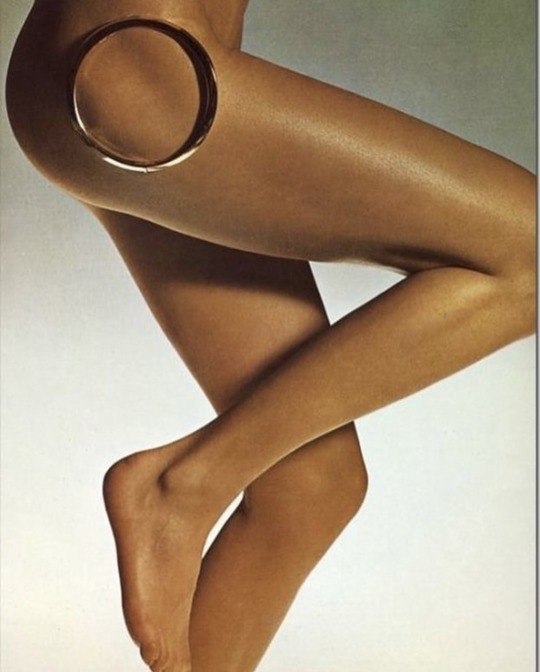
Source: Katie Wells via Wellness Mama
Photo: @nineteenikey
When it comes to cellulite, it seems that hormones, diet, lifestyle, and genetics all play a role but are not absolutes. While those who are overweight tend to have a higher chance of getting cellulite, many thin women complain of it as well.
Below are natural remedies that should all help balance the connective tissue/fat in the body and address the many possible causes. Either way, these things are beneficial for other reasons too so they are worth a try!
1. Dry Brushing
This is one remedy that there may not be any scientific evidence that it works but that there is a lot of anecdotal support for. Either way, it feels great and helps stimulate blood and lymph flow in the body. Here are some specifics:
How often: Dry skin brushing effectively opens up the pores on your skin. This is something you can — and should — be doing daily, even twice a day. Your skin should be dry, so the ideal time is in the shower before you turn on the water. Just a reminder, don’t get the brush wet.
Direction: You should only brush towards the heart. Making long sweeps, avoid back and forth, scrubbing and circular motions. Start at your feet, moving up the legs on both sides, then work from the arms toward your chest. On your stomach, direct the brush counterclockwise. And, don’t brush too hard: Skin should be stimulated and invigorated but not irritated or red.
2. Consuming Gelatin
Gelatin is largely composed of the amino acids glycine and proline, which many people don’t consume in adequate amounts as they are found in the bones, fibrous tissues and organs of animals and as a population, we don’t consume these parts as much anymore. These amino acids are needed not only for proper skin, hair and nail growth but for optimal immune function and weight regulation!
According to many sources (which I go over in this post), the various health benefits to gelatin include:
* Supports skin, hair and nail growth
* Good for joints and can help joint recovery
* Can help tighten loose skin (like the kind you get after having four babies in five years…)
* Can improve digestion since it naturally binds to water and helps food move more easily through the digestive tract
* Rumored to help improve cellulite
* Great source of dietary collagen (side note: collagen is too large to be absorbed by the skin, so those skin creams are pretty useless… get it internally and use coconut oil for lotion!)
* Source of protein (though not a spectacular one) but its specific amino acids can help build muscle.
One theory is that the decline of gelatin containing foods in our diets has led to an increase in cellulite as we don’t have the needed building blocks for healthy connective tissue. Either way, it is another remedy that is good for other reasons and worth a try.
3. Myofascial Massage
One theory is that cellulite forms in the superficial fascia, a layer of connective tissue below the skin that contains fat cells. Superficial fascia is fibrous and due to inactivity, injuries, and improper exercise, adhesions (scar tissue) in the fascia can form contributing to the bunched-up or rippled look of the skin. Not only does the superficial fascia become more fibrous, thickened and coarse, less flexible, but it can also adhere to underlying structures that it normally slides over.
Some therapists are able to perform a type of massage called myofascial massage or myofascial release, which smoothes this layer of connective tissue and can apparently also help with some types of muscle and joint problems that are related to imbalances in the fascia.
For those of us who don’t have access to a regular massage, it seems that using a deep tissue foam roller (like this one) regularly can greatly help as well.
4. Coffee Scrub
Coffee scrubs can be beneficial in reducing cellulite as well. The massage and exfoliation benefits skin by stimulating blood/lymph flow and the caffeine in the coffee has a tightening effect.
Coffee smells great and this scrub will exfoliate skin:
You will need:
* 1/4 cup coffee grounds
* 3 TBS sugar or brown sugar
* 2-3 TBS of melted coconut oil
What to do:
Combine the ingredients to create a paste-like consistency (note that it will harden if cooled if you are using unrefined coconut oil). Store in a glass jar.
To Use:
Massage into skin for several minutes using firm pressure and wash as usual. Use 2-3 times a week. Results should be visible within a couple of weeks.
5. Kettlebells
Kettlebells are one of my favorite ways to work out and they are especially good for the hips/thighs/buttocks/stomach areas (don’t believe me? do one kettlebell workout and let me know how your thighs feel the next day!)
Increasing blood flow to these areas can help remove cellulite and kettlebells are one of the most effective ways to build muscle and burn fat (both which help minimize the appearance of cellulite). They aren’t expensive (I use these) and don’t take up much room to store. Admittedly, you do have to make sure there are no kids nearby when you use them!
6. Omega-3s
Another theory is that consumption of the wrong kinds of fats leads to an imbalance of the fatty acids that the body needs for smooth skin and tissue. There is some evidence that consuming enough omega-3 fatty acids and fat-soluble vitamins will help reduce cellulite over time. Either way, omega-3s, and fat-soluble vitamins are important for many other functions in the body, so it won’t hurt to try it!
Personally, I take these fish oil capsules daily for skin health (and for many other reasons).
7. Detox Baths
I love detox baths because they are relaxing, but yet another theory proclaims that toxin build-up in skin and fat tissues lead to cellulite. I couldn’t find any scientific evidence to back the toxin claim, but detox baths can be relaxing and great for the skin in other ways, so they are worth a try!
8. Moisturize Naturally
Just as detox baths may help remove toxins that can lead to skin problems (and maybe cellulite), constantly adding toxins back to the skin in the form of chemical-laden beauty products probably doesn’t help much! If you haven’t already, try using natural options for skincare and moisturizing. Simple coconut oil will work as an all-purpose moisturizer, but if you want to get a little more sophisticated, there are tons of recipes for your own DIY natural lotions.
9. Balance Hormones
It seems that many sources agree that hormones play a large part in cellulite formation (one reason that women typically get it and men don’t) and that working toward proper hormone balance can help reduce cellulite. Even if it doesn’t get rid of cellulite, balancing hormones helps in so many other ways that it is worth working on!
1 note
·
View note
Text
The Surprising Beauty Benefits of Acupuncture
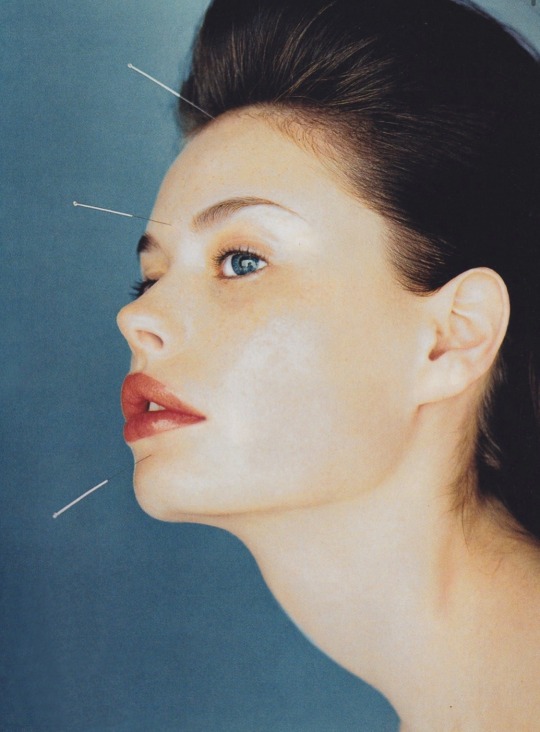
Author: Eviana Hartman via VOGUE
Photo: Vogue, September 1997
Acupuncture has been popular since ancient times for a reason: It makes people feel better. What’s more, in recent years, patients undergoing the procedure to treat health concerns have often noticed that their looks have benefited, too—leading to a rise in “acupuncture facials” that combine whole-body rebalancing with targeted needle stimulation (and, sometimes, spa-like add-ons) for glowing skin. Less well known, however, is the fact that the technique can also be used to address specific, pesky cosmetic issues—and as it turns out, those are one of the first things a practitioner might look at when diagnosing you.
“In traditional Chinese medicine, we look at the face as a reflection of what’s going on inside,” explains New York City acupuncturist Shellie Goldstein, M.S., L.Ac. “We look at your internal well-being to decipher what’s going on. From the inside, we will make that change, and it will be reflected on the outside.” In other words, the lasting solution to your breakouts or sagging skin might not be a cream or device, but rather a healthier, more balanced body.
Here, Goldstein explains five specific ways that acupuncture can provide a beauty boost from the inside out.
De-Puff
A swollen face is likely a sign of larger issues, according to Goldstein—issues that acupuncture is designed to address. “If you have digestive problems, allergies, or poor lymphatic drainage, what you may see in the face is puffiness,” Goldstein explains. “Not only will we correct it, we will adjust it from the inside.” This is accomplished by inserting fine sterile needles at certain points on the body identified in traditional Chinese medicine. Each resulting “micro-trauma,” as Goldstein calls it, causes a healing response both locally and throughout the body; different points correspond to different bodily systems.
Clear Up Acne
Acupuncture’s rebalancing effect has a way of calming breakouts, whether chronic or caused by monthly hormonal fluctuations. “We look at acne as a reflection of internal heat, and the digestive system,” Goldstein explains. “We can adjust premenstrual breakouts through acupuncture as well by treating the heat that arises” in the body during certain times of the month.
Calm Rosacea
“Similar to acne, it’s about adjusting that internal balance within,” Goldstein says. “Rosacea in Chinese medicine is often about digestion—by clearing up the internal digestive issues, it really helps to minimize redness and irritation in the skin tissue.”
Brighten Dull Skin
Acupuncture can boost a lackluster complexion both directly—by triggering local healing processes in the face—and indirectly, by recalibrating bodily systems. “Simply by putting a needle in the skin, you’re stimulating skin circulation, lymphatic drainage, and collagen production,” Goldstein says. But also, “dullness can often be a lack of energy flowing through the body properly. We work to raise your energy and balance what’s going on.”
Tighten and Tone
Whether your concern is the gravitational pull on your legs or slack facial skin, according to Goldstein, a few needle pricks can help to firm things up. Acupuncture is “absolutely amazing for muscle tone and deeper tissue tone in the body,” she says. “It will help to relax the deeper tissue muscles that are too tight, and tighten the ones that are [loose]. It’s really good for lifting and sculpting the cheeks and jawline, and even for lifting eyebrows.”
0 notes
Text
Best Time to Take Vitamins
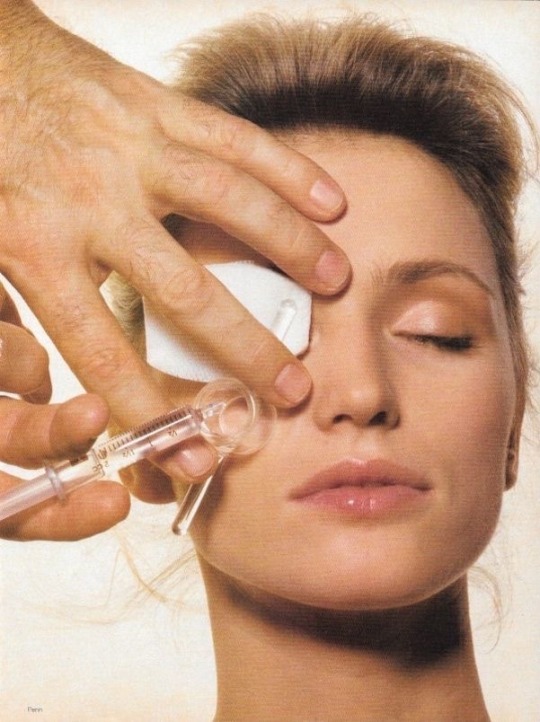
Source: Kathryn Watson via healthline
The best time to take your vitamins depends on the type you’re taking. Some vitamins are best taken after a meal, while it’s best to take others on an empty stomach. Establishing a routine of taking a vitamin at the same time every day will form a healthy habit. It will also help you get the most out of your vitamin supplement.
Not every vitamin breaks down in your body the same way. For that reason, it’s a good idea to know if you’re taking your vitamin at a time of day that will give you the most benefit.
Fat-soluble Vitamins
The optimal time to take fat-soluble vitamins is with your evening meal. Fat-soluble vitamins are dissolved in our bodies using fats. They are then carried into our bloodstream and perform essential functions. These vitamins include vitamin A, vitamin K, vitamin E, and vitamin D.
When our bodies get extra fat-soluble vitamins, they are stored in the liver. These vitamins are best taken with a meal that contains saturated fats or oils to help you absorb them.
Water-soluble vitamins
Water-soluble vitamins absorb best on an empty stomach. That means taking them first thing in the morning, 30 minutes prior to eating, or two hours after a meal.
Water-soluble vitamins dissolve in water so your body can use them. Vitamin C, all B vitamins, and folate (folic acid) are water soluble. Your body takes the amount of the vitamin it needs and flushes out the rest through urine. Since your body doesn’t store these vitamins, it’s a good idea to incorporate them into your diet or take a supplement.
B Vitamins
For a good start to your day, take a B vitamin on an empty stomach when you first wake up in the morning.
B vitamins are a special family of water-soluble vitamins that are energy-boosting and stress-busting. Some of the most popular B vitamins are B-2, B-6, and B-12. It’s been clinically proven that B vitamins can reduce the amount of stress you feel and improve your mood.
It is key to also be aware of possible interactions between your vitamins and prescription drugs you take. For example, you shouldn’t combine vitamin K supplements with the blood thinner warfarin (Coumadin).
Be aware of the other foods you’re eating so you’re not getting too much of any one vitamin. This can throw your body off balance. Many cereals, “enriched” dairy, and grain products have vitamins added to them as selling points. Always be cautious about what you’re taking if you are pregnant and nursing. Most supplements haven’t been well-tested for infant safety.
Always choose supplements from a reliable source because the FDA does not monitor vitamins and supplements for purity, quality, or safety like other drugs.
0 notes
Text
Costa Brazil’s Óleo Para O Corpo: Kaya Jungle Firming Body Oil
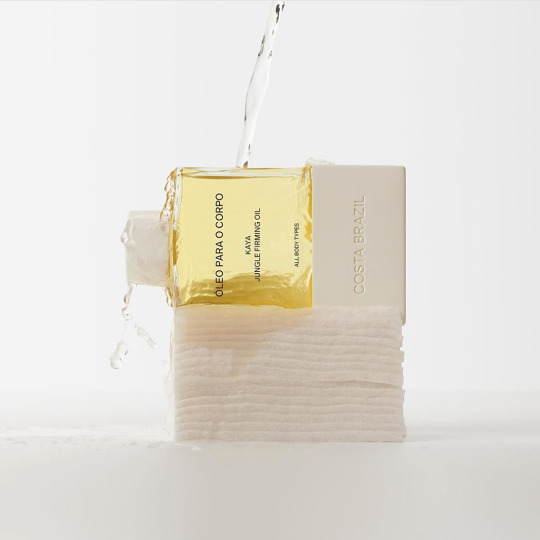
Awaken the body with this high-performance, lightweight body oil that helps soften, tone, firm, hydrate and brighten the skin while unlocking your natural radiance. The cold-pressed Jungle Complex™ of rare Amazonian ingredients promotes firmer, healthy-looking skin. Rich in omegas 3, 6, 9, and Vitamin A and E.
Active Ingredients:
Kaya Oil: Helps improve the appearance of skin tone & appearance
Cacay Oil: Smooths skin and reduces the appearance of fine lines
Breu Branco: An aromatic natural resin with a calming effect on the body and mind
Tucuma Seed Oil: Revitalizes dry skin and helps improve skin firmness
Brazil Nut: Moisturizes and gives skin a soft, smooth appearance
Buriti Oil: Nourishes, hydrates and helps firm skin
Cupuaçu: Nour ishes and emulsifies to replenish skin with essential fatty acids. Strengthen skin’s lipid barrier to enhance your natural glow
Murumuru: Deeply hydrates skin and features Vitamins A & C which help to promote a brighter, more radiant appearance
Pequi Seed Oil: Rich in essential fatty acids that moisturize skin
Patua Seed Oil: Hydrates and helps restore firmness
Smooth over damp skin and massage in circular motions. Use daily to brighten your body and spirit. Rub gently into tips of your hair for a healthy gloss.
#geniusproducts
0 notes
Text
My Personal Hair Care Routine

The post you have all been so patiently waiting for and also one of the few non-curated, originals you will find on Genius, written by me. This has probably been one of the most highly requested post ever — people always ask me this, whether I am on Instagram live or simply looking at my message requests on my personal account. While I do have to say that I have won the genetic lottery when it comes to my hair, there are certainly tips I can share to enjoy healthier, happier hair.
My hair is naturally perfectly straight, it is long, silky and extremely shiny. Like I said, I feel like I have truly won some sort of genetic lottery because it is just so low maintenance and somehow always looks very nourished, no matter what I do. However, I do pay close attention to how I care for it regardless. Here are some of my favorite hair care tips that, I myself stick to and that basically sum up my hair care routine.
1. Brushing
The way you brush your hair can make a huge difference in your hair health. I always brush starting from the ends and moving up, never brush wet hair (as wet hair is more fragile and can, thus, lead to more breakage) and always use my tangle-teezer brush (or a knock off tangle teezer works just as well — as long as it is that type of brush).
2. Washing frequency
I used to wash my hair every day but this, as you can imagine, is not good for your hair. It strips your hair from all of its’ natural oils prematurely and can dry out and weaken your hair. Especially if you use heat on your hair. I try to wash my hair only when I really need to. I try to go as many days as I can in between washes. Usually, this means washing my hair every third day or so. Additionally, I try to limit the amount of heat I put on it — always resorting to air drying my hair when I can escape using my blowdryer. As you probably already know, heat is not good for your hair so the less you use it the better. I have been extremely blessed - I have never used a straightener and even when I let my hair dry naturally, it always looks the way it does and I find no difference compared to when I blow dry. A pro tip however is, if you do use heat, at least invest in a good heat protectant spray! Any time I have to use the blowdryer I protect my hair by using a product like that.
3. Shampoo and conditioner choice
Again, my hair has a very strong character, in the sense that, no matter what products I use it always ends up looking the same - just how I love it. I do, however, try to go for natural, chemical-free and cruelty free hair products. I like natural remedies for anything in life and my hair is no different. I am probably the least helpful here because I genuinely do not have a favorite product when it comes to shampoo and conditioner. A good note though is that I do use both, every time I wash. My hair is so low maintenance that even if I were to wash it with hand-soap and no conditioner (or as tabloids like to call it when talking about my hair in the media: laundry detergent) it always looks the same way you have seen it.
Some additional things I do to care for my hair are sleeping on a silk pillowcase, which is great not only for hair but also your skin. I have done a post about this in more detail earlier, on Genius. I also am very careful with the kind of hair ties I use — i like to choose silk scrunchies as they are, in my opinion, the least harsh on your hair. I like to avoid any potential threat of breakage at all costs. I also switch up my hairstyle (unless I am simply wearing my hair down) quite a bit for this same reason. Ponytails, braids, but never the same thing too many days in a row as this can also lead to breakage. I also incorporate food that is great for hair health such as fish, avocados and berries. In the future I might do a post outlining the best foods for hair health maintenance!
As you probably already notice, I do not do much with my hair and my routine is pretty simple. Everyone is different so you really have to see what works best for you. What works for me may not be the best option for you. However, it has been a topic many of you have been extra curious about so there you have it!
0 notes
Text
Fast Carbs versus Slow Carbs

Source: Chris Daniels via SFGate
At the molecular level, all carbohydrates are chains of simple sugars. For your body to make use of the energy and nutrition in carbohydrates, the carb molecule must first be broken down into individual sugars to be absorbed in your intestines. Depending on the structure of the carbohydrates molecules, this process of digestion can take place rapidly or slowly. The glycemic index measures how fast this digestion process occurs.
Glycemic index, GI, is calculated based on how quickly carbohydrates in food lead to an elevation of your blood sugar. The faster carbs rank in a food digest, the higher the glycemic index; the slower they rank, the lower the GI. Glycemic load, another measure of how carbs are digested, reflects the overall level of digestible carbohydrates in food without regard to how long they take the digest.
Glycemic index and glycemic load interact to describe how your body digests carbs in food and give an estimate of how your body will handle carbs. A food with both a high glycemic index and high glycemic load may elevate your blood sugar higher than your body can handle, disrupting hormone and metabolism and leading to an elevation in body fat.
Examples of Fast Carbs
Foods with a high glycemic index include processed carbohydrates such as breads, cereals, sugars, fruits and some starchy vegetables. These foods are considered fast carbs. The carbohydrate molecules in these foods are smaller, especially in the case of sugar, and are broken down rapidly into sugars in your intestines. If eaten regularly, fast carbs can keep your blood sugar elevated, causing weight gain and an elevated risk of type 2 diabetes, obesity, metabolic syndrome and cardiovascular disease.
Fast carbs are extremely beneficial when eaten following exercise. The rapid rise in blood sugar is critical for restoring glycogen -- sugars stored for energy -- in the muscles and liver when eaten within two hours of exercise, according to nutritionist Dr. John Berardi.
Examples of Slow Carbs
Foods with a low glycemic index are considered slow carbs, which include most vegetables, whole grains, seeds, nuts, beans, peas and legumes. Slow carbs also tend to be higher in fiber, an important but often lacking nutrient. Slow carbs can provide your body with energy over an extended period of time without a rapid elevation in blood sugar. Choose foods with slow carbs throughout the day as a cornerstone of a healthy diet. A low glycemic index diet can aid in weight loss when combined with regular physical activity and can help the management of diabetes and other medical conditions, according to MayoClinic.com.
Eating More Slow Carbs
Simply making the switch from refined to whole grain is the easiest way to up the amount of slow carbs in your diet. As well, replacing some of your grain intake with higher-fiber legumes and beans can help — for example, making a rice pilaf from a mix of brown rice and lentils, instead of white rice. You'll also get slow carbs from vegetables, so make sure to serve veggies at each meal. Treat processed fast carbs as an occasional treat, and practice portion control on healthy fast carbs, like fruits.
0 notes